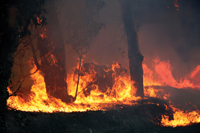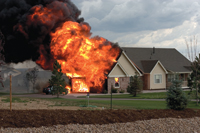
Features
Structural
Training
Trainer’s Corner: June 2010
For more than two decades, I have taught the wildland fire suppression
and firefighter safety classes to wildland and structural firefighters.
Next to firefighter safety and fire behaviour, the major emphasis is
placed on mop-up. The first priority is to contain the fire. Once we
have the fire contained by use of a fire line adequate for weather
conditions, fuel type and terrain, we concentrate on extinguishment.
June 4, 2010
By Ed Brouwer
For more than two decades, I have taught the wildland fire suppression and firefighter safety classes to wildland and structural firefighters. Next to firefighter safety and fire behaviour, the major emphasis is placed on mop-up. The first priority is to contain the fire. Once we have the fire contained by use of a fire line adequate for weather conditions, fuel type and terrain, we concentrate on extinguishment.
 |
|
| More than an embarrassment for the responding agency, a rekindled fire is an indicator of a poor firefighting operation, and can certainly be subject to legal action.
|
It is difficult to get structural firefighters excited about fighting fire with a shovel, pulaski or a grub hoe. Unfortunately, fire departments still respond to wildland fires with the simple plan to “put the wet stuff on the red stuff”. Although this works in most structural fires, it is not the most effective approach to wildland fire suppression. In wildland fire fighting, the best thing is to let the fire burn up the fuel – contain the fire and let it burn itself out. What is burned up will not burn again. This brings us to the discovery of one of the few “dirty” words in the Canadian fire service: rekindle. A rekindle is a term used by firefighters to describe a blaze that re-ignites after they leave a scene.
Much more than an embarrassment for the responding agency, a rekindled fire is an indicator of a poor firefighting operation and can certainly be subject to legal action.
Last April in Conway, S.C., firefighters responded twice to a weekend yard fire that officials believe rekindled four days later, igniting a massive wildfire that destroyed 70 homes and charred 31 square miles near Myrtle Beach. No injuries were reported but damage estimates rose to $16 million.
There seems to have been some discrepancy about the fire department’s initial response but it appears it responded to the property not once, but twice, to extinguish a grass fire. It also appears that the second response was to extinguish a rekindle that resulted from improper mop-up procedures from the fire alarm. The fire department says the property owner is responsible for the massive fire, claiming he started the fire in the first place. The property owner says that while he may have allowed his fire to get out of control, the fire department told him that the fire was out (twice) and that there was nothing to worry about. He says he can’t understand how he can be blamed for a fire that wasn’t properly extinguished by supposedly trained professionals.
 |
|
| After overhaul has been completed, the fire ground commander should keep everyone out of the building and post a fire watch if necessary. |
Wildland firefighters use the term re-burn to describe a fire that is out but later rekindles. But isn’t that an oxymoron? Whether structural or wildland, firefighters must ensure the fire is not smoldering in some hidden area. Mop-up and overhaul, although seen as the least glamorous tasks on the fire ground, are of vital importance.
Experienced fire officers know that certain types of materials are more difficult to fully extinguish and are susceptible to rekindling. For example, burned and smoldering mattresses, bedding material and stuffed chairs are some of the most difficult materials to fully extinguish. Firefighters often remove a mattress or stuffed chair from the building even after it is quenched with water during overhaul.
Ordinary clothing, when hanging in a closet, can conceal a smoldering fire. Pockets of air between the layers of clothing and the added problem of plastic covering over clothing from a dry cleaner increases the chance of a smoldering fire going unnoticed. Burned clothing must be removed from the closet, pulled apart and wet by a hose stream.
Tree stumps and deep duff are the areas of concern for wildland firefighters. Fire can burn for hours, even days, in the fine root systems under ground. Burning slash piles can push heat and fire many metres into the ground. Even when the above fire has been extinguished, hot ash and burning embers can be uncovered by hydraulicing with a water stream. In one case, we were called to a rekindle of sorts (smoke puffing from the ground) three months after the initial slash pile was burned.
■ Tips for wildland mop-up and structural overhaul Both
- It may be necessary to limit overhaul until the fire cause has been determined by fire investigators. Firefighters need to preserve evidence and protect the point of origin.
- The thermal imaging camera is a great tool but it takes experience to know the difference between residual heat images and smoldering heat images. Visually check if there is any doubt.
- Overhaul can be just as demanding as the fire attack. Numerous injuries happen at this stage of the incident, and most are preventable. Falls still rank as a leading cause of firefighter injuries and deaths, and a considerable number of fatalities have occurred during the overhaul phase.
- To increase overhaul efficiency place exhausted firefighters who have extinguished the blaze in rehab and bring in fresh firefighters to do the mop-up and overhaul. Make sure members are wearing SCBA and PPE during overhaul (off-gassing of toxic fumes is of real concern). Many firefighters and fire investigators use full-face respirators during overhaul. They are excellent for filtering particulates and dust in toxic environments, but there’s really no substitute for SCBA.
- If you do not set up a fire watch, follow your department’s SOGs as to revisiting the scene to ensure due diligence regarding rekindles.
Wildland
- The fire fighter’s primary job is to construct the fireline. The fire fighter digs below the surface of the ground to the mineral layer of soil. This procedure clears fuels (dry leaves and duff, including roots) and prevents the fire from spreading. On average, the fireline built with hand tools is not more than 30 to 60 centimetres wide. The depth of the line is always to the mineral layer of the soil.
- Once the fire is contained, overhauling involves moving in towards the centre one hose length at a time. This provides a consistently increasing fire guard all the way around the fire.
- Make mud puddles in those hard to extinguish spots and soak the burning duff.
- Extinguish all smoldering material along the fire edge after the spread has been stopped. Place all rolling fuel so it cannot roll across the line or trench below it. Make sure that all burning fuel either burns itself out or is spread or buried to stop spark travel. Clear the line on both sides of all special threats such as snags, rotten logs, stumps, singed brush and low-hanging tree limbs. Search for underground burning roots near the line. Mop up all material adjacent to the line on large fires to make sure the fire cannot blow, spot or roll over the control line. Cold trailing is a method of determining whether a fire is still burning. It involves careful and methodical inspection of burned material and the surrounding area by carefully feeling with the bare hand. Once a fire is controlled and mopped up, the fire boss will declare the fire to be on a “patrol” basis. The job of the fire patrol is to walk the control line to prevent escapes, discover and control spot fires and mop-up whenever necessary. If there is no forestry personnel to do this a couple of firefighters may have to take turns. A fire patroller will also keep a sharp lookout for “sleepers.” Sleepers should be spotted before they have a chance to ignite the adjacent fuel and cause the fire to escape. A sleeper is a hidden fire, deep inside the duff layer or in a root tip. As well, there is no glowing stage. The “sleeper” is aptly named – it may take weeks before an adjacent patch of fuel is brought up to ignition temperature. Until then, it normally defies detection.
Structural
- Consider filling a bathroom sink or tub in the burned-out structure with water and soak small amounts of smoldering materials in water.
- Remove smoldering mattresses and stuffed chairs to the street, then soak them with water outside. (Be careful when removing smoldering mattresses and stuffed chairs. They have ignited in hallways and stairs during the carry out. One superintendent of a high-rise apartment house tried to remove a smoldering couch down to the street in an elevator. As the elevator descended, the couch flared up due to the fresh air moving through the elevator during the descent. The superintendent and the couch were found incinerated in the elevator car on the first floor by firefighters when they arrived.)
- If the fire is at night the investigation may be delayed and you may want to post a fire watch until morning. The benefit here is that a fresh crew performing overhaul in the daylight will be a safer operation. Otherwise, the incident commander, the safety officer and the appropriate company officers should perform a building/scene safety survey to identify health hazards. If you suspect hazardous materials limit overhaul to what is necessary to prevent re-ignition. Be aware of weakened structural members, holes in floors, burned-out stairways, leaning chimneys and walls. Flag or cordon off any structural hazards and inform all personnel of their locations.
- After the fire has been extinguished and overhaul has been completed, the fire ground commander should keep everyone out of the building and post a fire watch if necessary.
Several years ago we attended a wildland fire on Black Mountain in Kelowna, B.C. When we had the fire contained, I walked over to where there had been a lightning strike fire three months earlier. As I walked around the old hand guard, I noticed that the fire had actually escaped. The hair on the back of my neck stood on end. Fortunately, it had put itself out, but the escape was made possible by a five-inch root that had not been cut out where it crossed the guard.
Whether you are a volunteer or career department, to have a fire that has been controlled and apparently mopped up start again – hours, days or weeks later – can only be classed as an inexcusable failure.
Ed Brouwer is the chief instructor for Canwest Fire in Osoyoos, B.C., and the training officer for West Boundary Highway Rescue. The 19-year veteran of the fire service is also a fire warden with the B.C. Ministry of Forests, a wildland interface fire suppression instructor/evaluator and a fire-service chaplain. Contact Ed at ed@thefire.ca
Print this page